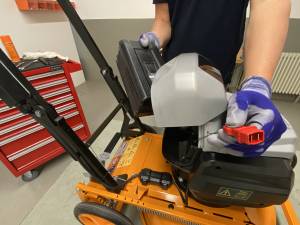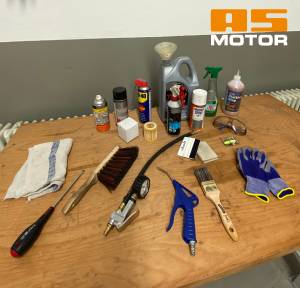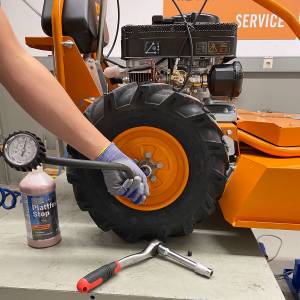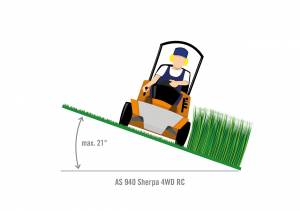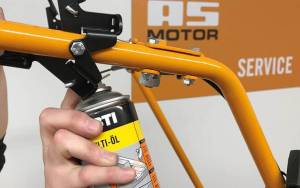Fit into hibernation - Fit for the coming season - Part 1
The ideal time for a comprehensive equipment check of lawnmowers, ride-on mowers and other motorised gardening aids is when preparing the machines for winter. Hardly anyone knows what to take into account for this process better than Wolfgang Gerlach. The trained mechanic has been working for 35 years at high grass mower manufacturer AS-Motor in Bühlertann.
In a small series, we have summarised the engine expert’s extensive knowledge of winter check-ups. In the first part, we first deal with basic things that need to be observed, and then dive into detail regarding the bodywork, frame and mower deck.
Benefits of the Winter Check-up
A comprehensive equipment check before storing machines for the winter kills three birds with one stone. Firstly, the machines are properly cleaned and permanently preserved; secondly, by checking the functions errors are detected. Thirdly, it shows where there is a need for action or repair by a specialist. The main aim is to ensure that the motorized helpers are functional and ready for use the following spring. Occupational safety is also an important factor here. Blades and flails are exposed to constant high stress and wear. At blade speeds of sometimes more than 200 km/h, everything must be in tip-top condition. The equipment check contributes to a machine’s extended service life and increased value retention.

Our engine expert: For 35 years Wolfgang Gerlach has been working at AS-Motor as a test mechanic in prototype construction and the engine test bench.
Before we get started
Every check-up begins with the necessary safety precautions. For example, the possibility of an accidental start of the machine must be eliminated before any action can be performed. For this reason, the main plugs must be disconnected on electric mowers. For battery-powered machines, remove the batteries and, if necessary, activate the off switch or remove the safety key. On motorized machines with a rope start, you must remove the spark plug connector. To be on the safe side with ride-on mowers, remove the ignition key and, if possible, disconnect the battery before starting work on the machine. Close fuel taps and tank ventilation. Basically, good ventilation must be ensured and the machine must be standing safely. Guarantee that no ignition sources are nearby and wear cut-resistant gloves.
Fresh shine and well lubricated
To clean the body and frame, first sweep away loose dirt, dust, leaves and branches with a hand brush. Stubborn dirt can be removed with a damp cloth and gentle cleaning agent. The expert from AS-Motor points out that decomposing, damp grass and leaves are particularly corrosive to metals and surfaces. Therefore, pay attention to rotten nests in corners and angles of your machine. The bodywork can be cleaned particularly gently and effectively with compressed air. We do not recommend the use of high-pressure cleaners, which degrease sensitive bearings and components. Cleaning additives are often particularly corrosive. Running water from the hose can be used instead. However, please also avoid sensitive and electrical parts and do not direct water jets at bearings.
Bowden cables and their outer shells can be checked while cleaning the bodywork. Chafe marks, kinks, bruises and broken strands impede correct functioning. Further damage can also result if, for example, a clutch does not disengage the transmission properly. For this reason, test the movement of the cables and the end fastenings. It is best to use a silicone lubricant to lubricate the Bowden cables. In contrast to oils and greases, silicone does not resinify, and less dirt sticks to it.
After cleaning, all joints, hinges and operating levers can now be lubricated with a resin-free multifunctional oil. Please note that no lubricant, oil or wax should get on drive or V-belts, pulleys, brake linings or dry clutches.
Clean mower
For proper cleaning, mowers must be set up, folded over or tilted to the side. This is no problem with electric or battery-powered mowers, which can be placed on either side as they have no oil in the engine. For combustion engines, please proceed as follows: Close the fuel tap and the fuel tank vent. If the tank cap leaks, drain the fuel beforehand. After removing the air filter, the mower can be put on its side. Please note that on 4-stroke engines the air filter housing must always be on top when the mower is folded down, i.e. above the crankcase. Otherwise engine oil will run into the air filter housing and contaminate the intake duct and air filter.
Service stands can be used to safely tilt a ride-on mower. These are available from specialist dealers. Otherwise, the machine can be driven on ramps to make it accessible from below. Secure the ride-on mower so it does not roll away or fall over.
Now you can start cleaning the mower deck. Please pay attention to the sharp cutting tools. There is a risk of injury here. It is best to clean mowers and mowing bonnets immediately after the last use, as the grass residue adhering to them will still be damp. Use tools made of wood or plastic for scraping, so as not to unnecessarily damage coated surfaces.
Although the use of a high-pressure cleaner is not recommended, it can make work much easier when cleaning the mowing deck. However, in this case it is essential to observe the following instructions: Only use it to clean the metal or aluminium surfaces on the underside of the mower housing, and do not use any cleaning additives. Avoid the blade bearings, crankshaft and blade clutch when working with the pressure washer and maintain a nozzle distance of 20-30 cm. After a wet wash it is advantageous to run the machine for a short time. Water residues will fly off the moving parts or be displaced by the air stream.
Are the blades still ok?
After cleaning, inspect the blades. Some questions must be answered: Are there any cracks, deformations or damages? Are the blades sharp or do they need to be sharpened? Has the wear of the blades already reached the minimum mark? Are the locking screws loose or worn? Are all safety guards or ejection guards intact?
If you discover any abnormalities during the inspection of the blade system and its protective covers, you must have a specialist workshop carry out any necessary repairs. Faulty blade systems pose a great danger to users and passers-by. Blade repairs may therefore only be carried out by a specialist. Even when simply resharpening blades and knives, it is necessary to check for imbalances afterwards. Without special tools, vibrations will permanently damage the machine.
Well protected through the cold season
After the cleaning and blade check, the mowing deck and blades are preserved from below and protected against winter corrosion. Use wax or oil-based care products for this. The AS-Motor Expert points out that no surface coating, whether paint, powder coating or galvanisation, will last permanently in a mowing deck. These surface coatings are no match for stirred up stones and sand, aggressive plant liquids and permanent moisture. Slight rust and corrosion are therefore normal. During regular operation, this plays an insignificant role in durability. Only long-term storage in a soiled condition will allow sheet steel to rust through. For this reason, the major annual cleaning should be carried out before the machine is left to winter.
